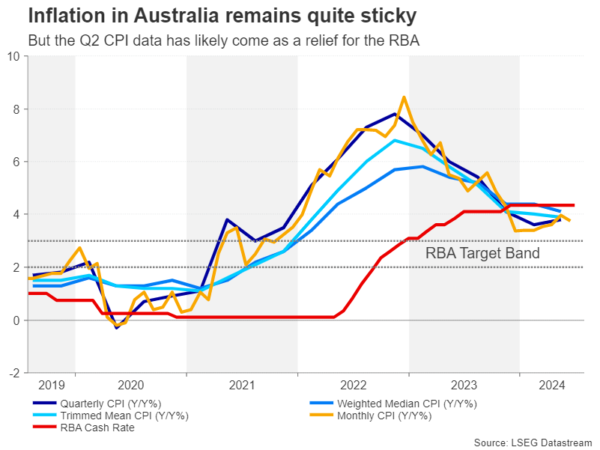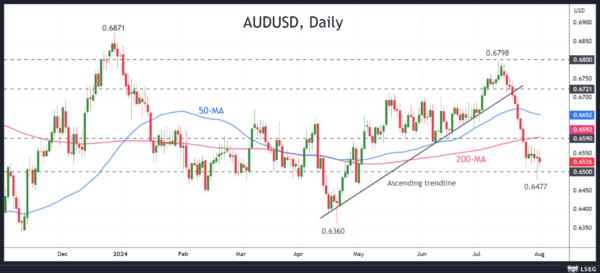- RBA set to keep rates on hold despite elevated inflation
- But latest CPI report raises hope that price pressures are easing
- A dovish pivot on Tuesday (07:30 GMT) could further devastate the aussie
Lack of progress
The Reserve Bank of Australia has barely made any progress on getting inflation down in 2024, with the monthly CPI gauge standing higher in June than where it was in December. The last two policy decisions in May and June were a close call but each time policymakers opted to forego a rate hike, even as inflation edged higher.
The new monthly CPI measure, which is still in experimental stage, climbed from 3.4% y/y at the start of the year to 4.0% in May. On that data alone, it can be argued that the RBA should have raised interest rates by at least another 25 basis points. But policymakers have been fretting about the weak economy, worried that further tightening could tip it into recession.
Yet, the real data has so far not supported the gloomy views and the labour market remains reasonably tight. But even if the economy did go into recession, a mild contraction is the worst possible outcome, which would hardly be a catastrophe when considering that Australia has enjoyed one of the strongest recoveries from the pandemic.
Finally, some good news on inflation
With growth indicators being inconclusive, a lot was riding on the Q2 CPI report to guide the RBA with its decision making ahead of the July policy meeting. Another set of hotter-than-expected readings would probably have given policymakers little choice but to hike rates on Tuesday. But it appears that their caution was warranted.
Although the headline figure rose from 3.6% in Q1 to 3.8% y/y in the June quarter, this was in line with forecasts. More importantly, the closely watched trimmed mean and weighted mean CPI measures both came in slightly below expectations and were down on the prior quarter, easing fears of a flareup in underlying price pressures.
The monthly rate also moderated, printing at 3.8% y/y in June – the first decline this year.
From rate hike to rate cut
This much needed relief in inflation is a major boost for rate cut hopes and investors have already priced out any prospect of a rate hike this year and are instead assigning around a two-thirds probability of a 25-bps reduction by December. For the Australian dollar, which is having its worst month against the greenback since January, the rising rate cut expectations couldn’t have cut a worst time.
The risk-off sentiment on the back of the tech selloff on Wall Street and the increased political uncertainty ahead of the US elections, combined with sluggish growth in China, have taken their toll on the risk-sensitive aussie. If the RBA acknowledges that there’s been some progress on getting inflation down to within its 2-3% target band and its updated forecasts show that this can be achieved within the next couple of years, then some kind of a dovish tilt is likely next week.
Is the ausse’s selloff about to get worse?
The aussie could extend its latest slide in such a scenario, bringing the April low of $0.6360 into range.
A more dovish outcome is if the RBA were to go further and open the door to a rate cut at some point this year. But this is unlikely in July and a hawkish surprise could not be ruled out either. For example, policymakers might maintain a neutral tone for now and wait for more evidence that inflation has resumed its downward trajectory before changing their language.
Given the scale of the aussie’s tumble since mid-July, a not-so-dovish meeting could spur a rebound in the currency, with the bulls targeting the 200-day moving average at $0.6592.
The Fed and China matter too
In the bigger picture, the Fed is expected to start cutting rates in September, while even if the RBA follows suit towards the end of the year, its easing pace is unlikely to match the Fed’s, so the aussie’s latest woes could be temporary. But as always, the economic outlook in China and global risk appetite will play a role as well, which at the moment, are acting more as headwinds than tailwinds for the aussie.














